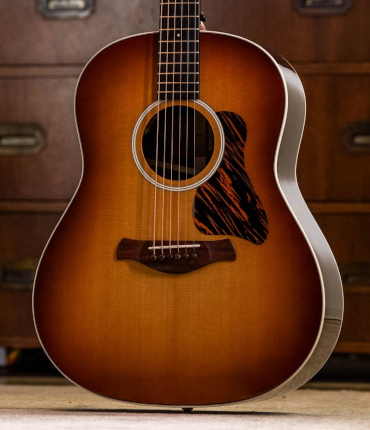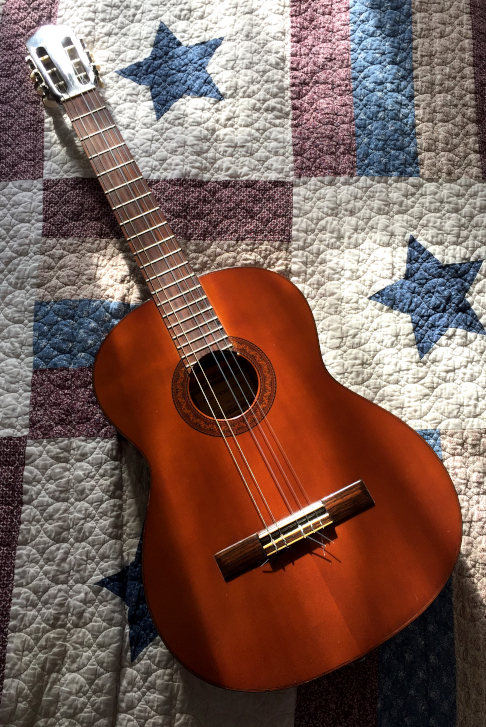Acoustic Guitars, et. al.
 One to Commemorate
One to Commemorate
I first encountered a Taylor guitar in 1999 at the studio where I work when Amy Grant came in to record with her 912ce. I was incredibly impressed with the sound, the projection, and the fit and finish of the instrument and decided I wanted a guitar that nice. On a holiday I went out shopping and got to play through the entire Taylor line from top to bottom at one dealer. One guitar, the Taylor K14c, stuck out, due to its responsiveness to a light touch. I did blind listening tests up and down the line and my lovely wife agreed that this guitar just stuck out when I played it. While playing the Taylors, I also became enamored with their precise intonation. Within a few months my wife bought this K14c for me to commemorate our twentieth wedding anniversary. The combination of koa body wood and cedar top made for an extremely intimate and light-sounding instrument and the inlays were both pretty and understated. The guitar is physically extremely light and resonant as well. It is one of the last two K14c models produced before Taylor switched over to the "New Technology" neck system. I should also mentioned that this particular guitar was started on the last day of Taylor production in the last year of the last century. Pretty cool, huh?
Due to what it commemorates, I've kept this guitar in pristine condition, only playing it at home and using it for studio dates. Nevertheless, I played the frets into the ground over twenty years. I had it refretted with stainless frets in 2022. The rather interesting story of how this guitar became a prodigal for an entire year away from me can be found HERE. Pictures, HERE.
 And Another One to Commemorate..
And Another One to Commemorate..I grew up in Martin country, where everyone who was anyone had a Martin, but for some reason I never got one. Then a few years back I heard a folk duo accompanied by a small-bodied Martin clone. I loved how this guitar had a confident single-string voice and still had great chord cohesion. I downloaded the song and continued to marvel over the sound of that guitar. Somehow I hadn't tried out a Martin when looking into GA- and GC-sized instruments. Over time I was exposed repeatedly to this sound and it grew on me. Finally, I identified the guitar that provided that sound, the Martin OM. Then on a vacation trip, my wife and I stopped by a huge Martin dealer and I tried out their OMs. Both my wife and I were enamored by the sound and the classic looks of this particular guitar. It indeed supported fingerstyle and strummed very nicely. The guitar was built extremely lightly. The rosewood sides and back were resonant and responded just like the guitars in the videos. So right there on the spot my wife decided to buy it for me as a commemoration of my fortieth year in the recording industry. This is a 2021 Martin OM-28 Standard Reimagined finished in a lovely, dark 1935 sunburst. My review is HERE. More pictures are HERE.

Something New...
I wasn't supposed to like this guitar. I went to the guitar store to look at small-bodied Martins... and three days later came home with this. This is a Taylor 717e from the brand new this year (2025) Gold Label series. It is a "Grand Pacific," meaning a slope-shoulder dreadnaught. In fact, this model only came out this month and this guitar was the first to arrived at the store, the day I visited. I'm pretty sure I'm the only one who played it before I brought it home. It features a torrified Sitka spruce top with "Fanned V-Class" bracing with "tonal route," rosewood sides and back, a mahogany neck with an ebony fingerboard and heastock overlay, a rosewood bridge with rosewood pins, and an LR Baggs pickup. It has amazing bass depth and clarity, a full, smooth midrange, and an articulate top-end. It strums wonderfully while still possessing great individual-string definition for fingerstyle. My review is HERE. Well, I resisted it for years, but I've finally acquired a classic Martin Dreadnought, a 2022 HD-28 from the Standard Reimagined Series featuring a sitka spruce top and East Indian rosewood back and sides. What does this guitar have that I don't already have? BOOM!!! A quickly-responding bass and a full sound. With the scalloped, forward-shifted bracing added to the HD model, this guitar returns to the pre-war spec that gave it its huge voice. The high strings also have a robust, full sound and pinch harmonics ring out easily. Compared to the guitar above, this one feels "wilder." The "H" actually refers to "herringbone," the fine herringbone inlay around the body margin. Aged top toner, a multi-stripe zig-zag center back inlay, a tortoise pickguard, and the abalone "Diamonds and Squares Short Pattern" fretboard inlay round out the visual aesthetic. Somewhere in the one year between the OM above and this guitar, Martin stopped staining their ebony. The figuring on the fingerboard and bridge attest to that fact. My review is HERE.
Here's a new 2011 Taylor 354ce. The shapely grand auditorium body is made with dark brown sapele that looks like mahogany and the top is sitka spruce with gentle silking. It has a very nice, smooth sound to it and handles strumming extremely well. The action is remarkably low and comfortable. In the '90s, Leo Kottke experienced hand issues and had to give up playing 12 string guitar. Then he discovered the Taylor 12 string guitars with their low action and was able to start playing 12 string again. He now has his own signature model. In the 2011 Expression System version 1.3, Taylor has finally come through with a natural, clear pickup sound. This guitar arrived with Elixer nanoweb strings and I think I'll stay with them. My wife and I first encountered one of these at a local guitar store. After trying several over a year, I finally snagged one for myself. Go HERE for a review and more pictures.
In Fall of 2000, Taylor came up with an extensive line of limited edition guitars they dubbed, "Legends of the Fall." In each of the offerings there were upgrades, from body and top woods to inlays, that added value to guitars from some of their existing lines, all at a very reasonable upgrade price. This 2001 314kce is one of those offerings. The "k" suffix in the model number refers to the fact that Hawaiian koa was substituted for the standard sapele as the body and side wood. The inlay on the back was also included, with non-cutaway models receiving an intertwined dual mirror image version and cutaway models receiving this treatment. On forums this inlay was jokingly referred to as "The Luthier Formerly Known as Bob Taylor." With its Fishman Prefix, this guitar has turned out to be an excellent guitar for combo stage work because of its strong resistance to feedback. Because I knew I'd be playing it out often, I upgraded its case to a Taylor Deluxe "Pink Poodle" model. This guitar lives at the studio as my "maid of all tasks."
 Boom!!!
Boom!!!

A Very Mellow 12 Stringer
 Stage and Studio Warrior
Stage and Studio Warrior
 A Lady From Spain
A Lady From Spain
One day my wife asked me to go out with her to get the vacuum cleaner repaired and I ended up with a BIG, surprise. This is a Cordoba 55R classical guitar with rosewood sides and back, a sitka spruce top, and a Spanish cedar neck with ebony fingerboard and reinforcement strip. The hand-inlaid rosette and binding block are nice touches on a very mellow, classic instrument. I would never have considered a spruce top for a classical guitar but we discovered this one in a guitar store and it really sang with authority and balance. After my wife fell in love with it, she set up a surprise trip to the guitar store under the disguise of a trip to the vacuum cleaner repair store and then even negotiated the deal with the manager. Viva la surprise! Click HERE for more pics.
 A Rootsy Addition
A Rootsy Addition
Lately there's been a revival of Blues-based music so I tracked down and added resonator guitar to use on recording sessions. That prospect is considerably harder than it might seem because there are so many kinds of resonators that yield such different sounds. With the help from friends I had to zero in on a sound and style and then find one that fit the bill. That guitar was the Gretsch G9202 "Honey Dipper Special," a resonator with a handsome, bell brass-body, a round neck, a biscuit bridge, and a very rootsy, bluesy sound. You can find out more HERE.
 Beginnings
Beginnings

